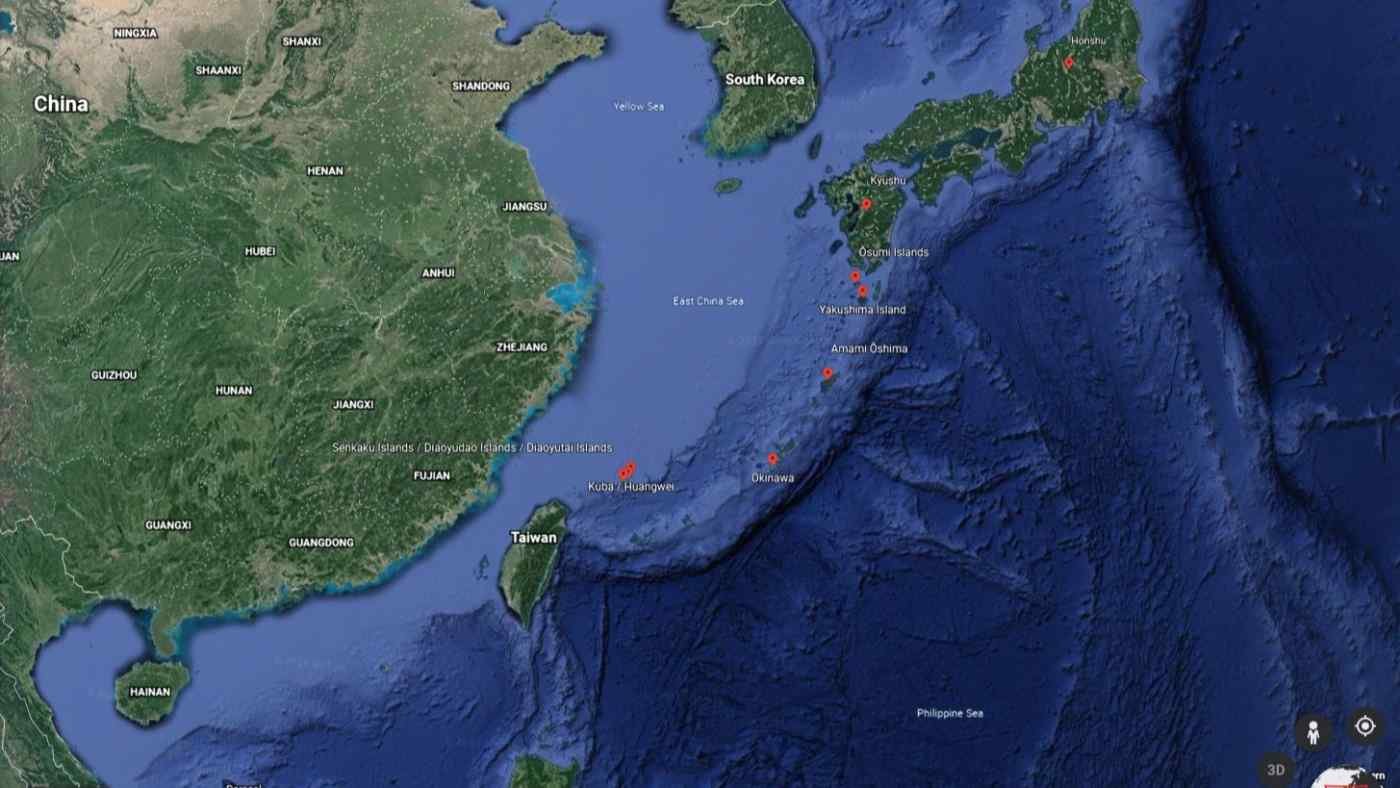US and Allies will exploit geographical vulnerabilities of Chinese Navy because of several choke points around China in case China attacks Taiwan and there is an all out war between China and the US allies.
In a recent article titled “US eyes using Japan’s submarines to ‘choke’ Chinese navy“, one thing is very clear that “for all its massive military buildup, China has some weaknesses that are hard to overcome. One of them is geography.“
The article talks about the shallow waters surrounding China in which Chinese Submarines can be easily detecte and are sitting ducks. The article talks about the scenerio in case of War between China and US-Allies and how Australian and Japanese submarines can guard different chokepoints. Defense chief Austin’s new ‘integrated deterrence’ demands deeper collaboration. But Defense chief Austin’s plan is silent about how to use naval assets of other allied countries in South China sea to block other choke points and prevent any Chinese Cargo ships to pass through those Choke points.
Shallow Waters Around China

“When you look at China’s submarine bases, every single one of them has a fair bit of shallow water that their submarines have to transit through in order to get to deep water,” Tom Shugart, a former U.S. Navy submariner, said.
A quick look at Google Earth shows that China’s coast is surrounded by light blue — which reflects shallow seas — in contrast to the dark blue deep waters that immediately drop off from the east coasts of Taiwan and Japan.
Once submarines are in deep water, they are almost impossible to find. Japanese and Taiwanese submarines can go straight into deep waters, a luxury their Chinese counterparts do not have.
Related Article China Threatened To Attack Australia If Australia Drags Itself Along With US In War Over Chinese Invasion of Taiwan
“For them to move from China’s near seas to the open ocean, they’re going to have to transit through different chokepoints and straits in the island chains,” said Shugart, an adjunct senior fellow at the Center for a New American Security think tank. “That will provide opportunities for an adversary — the U.S. and our allies’ submarine forces — to monitor more closely and try to intercept them if we were involved in a conflict, or in the run-up to a conflict.”
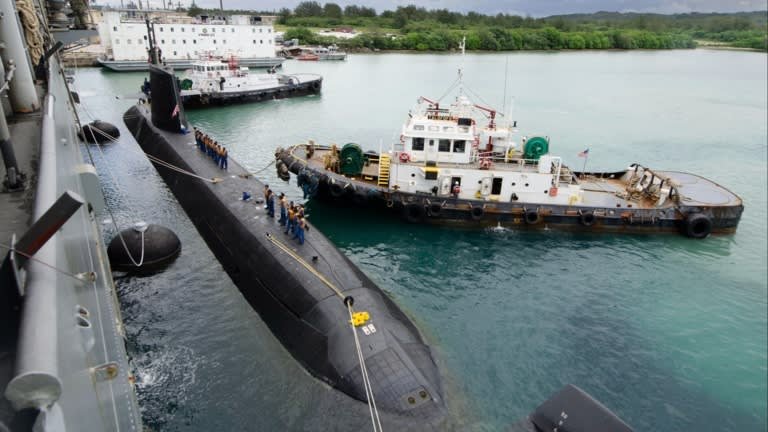
Chokepoint control could be one of Japan’s most important contributions in a potential conflict with China, said Jeffrey Hornung, a political scientist at Rand Corp.
President Joe Biden and Prime Minister Yoshihide Suga underscored “the importance of peace and stability across the Taiwan Strait” in the joint statement following their April 16 summit, the first reference to Taiwan in a U.S.-Japan leaders statement since 1969. This has prompted much discussion about how the two allies can work together if the peace were broken.
On Friday, U.S. Defense Secretary Lloyd Austin floated a new concept of “integrated deterrence.” It calls for allies to work “hand in hand” to prepare for a future war, which will look nothing like the “old wars” that Austin said he himself has executed over the past two decades.
Relate Article Australia Rejects To Be A Part of China’s BRI And Cancels Projects – What Next Is In Store?
Japan’s Nansei Islands chain stretches from the southernmost tip of Kyushu to the north of Taiwan. It consists of smaller groups of islands including the Osumi, Tokara, Amami, Okinawa, Miyako and Yaeyama chains. In April, the Chinese aircraft carrier Liaoning and five escort vessels passed through the Miyako Strait, a 250 km-wide waterway between Okinawa and Miyako, before heading south to Taiwan.
“Japan’s role should be chokepoint control,” Hornung said. “If you’re looking at the Nansei Islands, there are so many chokepoints that with the combination of the Maritime Self-Defense Force’s submarine capabilities and defensive mining, Japan could plug that up completely, and it would force the Chinese either all the way around Taiwan, or basically right into the battle space in the East China Sea, where the U.S. and Japan can plan for this and control it.”
Related Article China’s New Focus is Japan: Strategic Shift or Desperate Search for a Winnable Front?
“The more Japan could focus on defense — either with anti-ship cruise missiles or P-3C maritime patrol aircraft to find Chinese subs or then to hunt the subs — that would free up so many U.S. resources to be able to then fight the fight,” he said.
Hornung made similar recommendations in a recent research paper titled “Japan’s Potential Contributions in an East China Sea Contingency,” sponsored by the Under Secretary for policy at the Pentagon.
Shugart, the 25-year veteran submarine warfare officer, said Japan’s diesel electric submarines are especially fit for such a mission.
“The diesel electric submarine fleet of our allies like Japan and Australia can be very useful for chokepoint defense,” he said, noting that the mission is relatively stationary and the submarines are not required to move fast. “Diesel electric submarines are very quiet, so if you have a static location where you need to defend one chokepoint in an island chain, that’s a very useful place to put a diesel-powered submarine.”
Nuclear submarines, the likes of which the U.S. fields, are fit for the open ocean, chasing an enemy or preparing to launch a missile from an undetected location.
“Chokepoint island chain defense could be a useful way to employ diesel-electric fleets of the United States’ allies like Australia and Japan and maybe South Korea,” Shugart said.
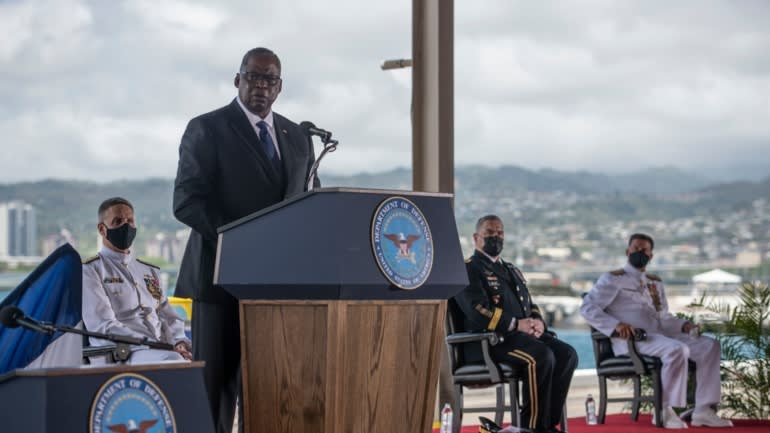
U.S. Defense Secretary Lloyd Austin speaks at the Indo-Pacific Command change of command ceremony, held at Joint Base Pearl Harbor-Hickam in Hawaii on April 30. (Photo courtesy of the Department of Defense)
That may be the type of collaboration the U.S. and its allies increasingly plan, as they prepare for the possibility of facing the advanced capabilities of China.
Austin’s discussion of integrated deterrence came during his first policy speech, delivered in Hawaii.
“The way we’ll fight the next major war is going to look very different from the way that we fought the last ones,” he said, emphasizing the need to “understand faster, decide faster and act faster.”
Deterrence has always meant fixing a basic truth within the minds of potential foes, Austin said.
“And that truth is, that the costs and risks of aggression are out of line with any conceivable benefit,” he said. “To make that clear today, we’ll use existing capabilities and build new ones, and use all of them in networked ways — hand in hand with our allies and partners.”
Retired Lt. Gen. Wallace Gregson, former commander of the U.S. Marine Corps Forces Pacific, said that Austin was speaking to three audiences.
The first audience is inside the Department of Defense, to break the silos among the different services, Gregson said. The secretary also was addressing the entire U.S. government, calling for an approach that employs all elements of national power.
Retired Lt. Gen. Wallace Gregson speaks at a Brookings event in Washington. The former top general in Okinawa said the U.S. and Japan need “eyeball to eyeball” consultation to achieve “integrated deterrence.” (Photo courtesy of the Brookings Institution)
The third audience consists of allies and partners, Gregson said, as Austin seeks to have a joint operational command element with countries such as Japan. Gregson, formerly the top American general in Okinawa, has seen U.S.-Japan coordination up close.
“I was thrilled to see Secretary Austin use the word ‘integrated’ — that’s a much, much more meaningful word, a much more powerful word than the jargon we’ve heard in the past, like ‘interoperability,'” said Gregson, now a senior director for China and the Pacific at the Center for the National Interest, a conservative think tank.
“We don’t do nearly enough work on contingency planning or on the development of operational concepts and developing the capability for U.S. and Japanese forces to be networked together so that we can fight as one cohesive force,” he said.
China’s overwhelming number of assets forces the U.S.-Japan alliance to coordinate better and make quicker decisions, Gregson said.
“What’s needed for the integration would be a detailed common operational picture of all the services,” he said, “so that there is an understanding of what everybody’s role is and a very rapid capability to react upon detection of threat, that doesn’t require consultation.”
Related Article Communist China threatens Democratic Taiwan with Invasion : Will US Protection be sufficient?
These capabilities demand “eyeball to eyeball contact between Americans and Japanese on a daily basis as we work through all these issues — a lot more contingency planning,” he said.
Straits of Malacca – Another Choke Point for Chinese Naval and Cargo Vessels
China is heavily dependent on Oil from Middle East. Though China has made vast reserves of Petroleum over the years, but if there are trade embargoes and trade sanctions and denial of transit to Chinese Navala and cargo vessels, in that case the next best choke point is Straits of Malacca.
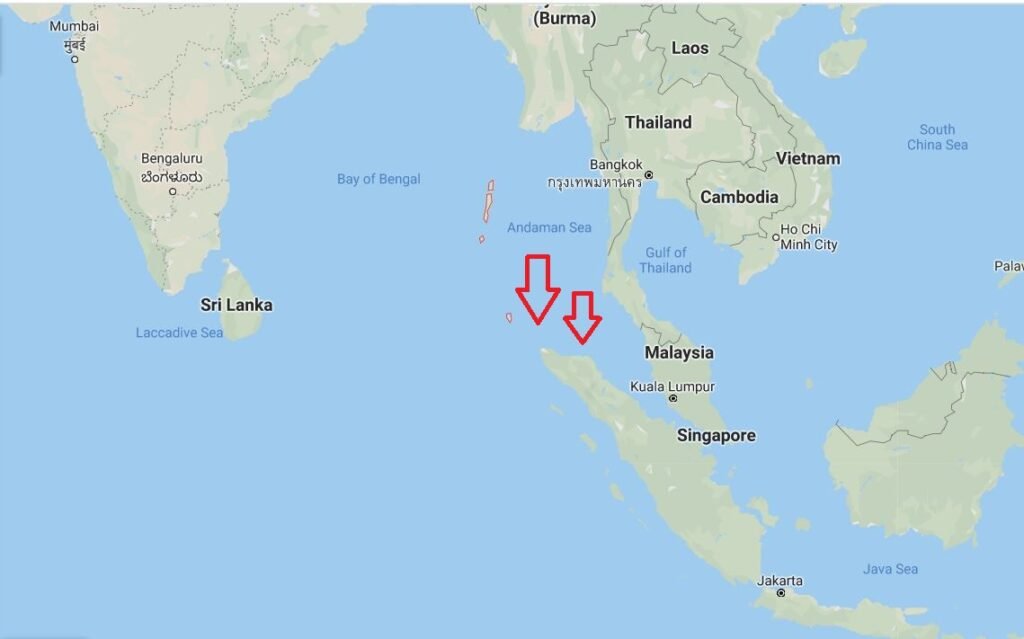
Straits of Malacca is a narrow, 890 km (550 mi) stretch of water between the Malay Peninsula (Peninsular Malaysia) and the Indonesian island of Sumatra and extreme southern Thailand to the east. As the main shipping channel between the Indian Ocean and the Pacific Ocean, it is one of the most important shipping lanes in the world.
In order to reach the Persian Gulf or Djibouti, Chinese Navy will have to pass through Indian Ocean near Andaman and Nicobar Islands and Straits of Malacca.
If there is a war and the transit of all Chinese vessels is to be blocked then any of the US allies in South China sea who participate in US lead war on China can block China’s access to Indian Ocean and cut the Chinese supply lines from the Straits of Malacca.
CPEC Passing through Pakistan – Independence of Balochistan
If the US and Allied forces are able to enforce embargo and prevent Chinese Naval and cargo vessels to leave and travel to China, China still has CPEC that is operational for 4-6 months in a year. CPEC Passes through Pakistan.
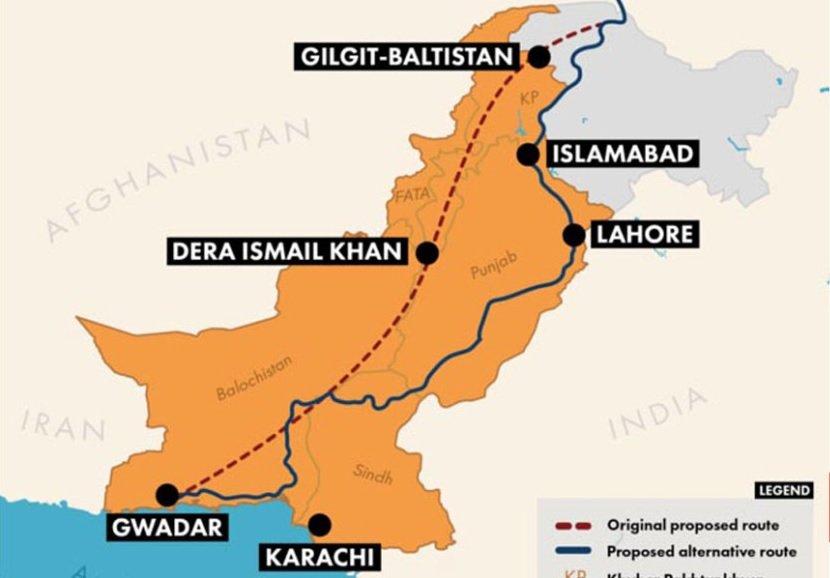
In order to cut off all supplies to China, it is essential that the CPEC should be destroyed. Chinese slave Pakistan Army will do everything to protect CPEC. There comes a time when US needs to recognize Pakistan Occupied Balochistan as a free and Independent Country and supply Balochistan National Army with necessary arms and ammunition including land mines so that the National Army of Balochistan can free their country and prevent any Baloch resources to transit through CPEC with total blockage. In case Pakistan Army tries to use its Air Force to attack Balochistan National Army, US needs to supply stringer missiles for defense of Baloch National Army.
Recognizing Free and Independent Balochistan will be a small price to pay for blocking supplies to China and an everlasting peace in Indo-Afghan region. Balochistan will act as a Buffer nation between Afghanistan and Pakistan.
Chinese Ports and Naval Bases in Other Countries
China also manages its ports and naval bases in several countries including Djibouti, Pakistan, Bangladesh, Sri Lanka, Maldives etc. Care should be taken by US and Allies to destroy the Chinese naval assets in all these countries before a meaningful blockade can begin.

Points to Ponder
What Newly elected President has done in first 100 days of his Presidency is to drive US allies away. US Main Stream Media propaganda outlets and Media Vultures that are already pocketed by China, are continuously targeting US allies and turning them against US.
Take an example of US when US media targets Scott Morrison Government very often.
If US wants to include India, in it’s war again China, Indian public will not support it because of US blocking access to raw materials for Vaccines for Chinese Corona Virus. Also very frequently US main stream leftist liberal propaganda outlets keep on defaming Indian Prime Minister Narendra Modi and his government. US administration has never tried to reign in on US based propaganda outlets.
Another example is of Saudi Arabia. Biden administration has taken several steps that have driven Saudi Arabia away from the US.
Given the big mouth of US politicians and US Leftist MSM propaganda outlets that are continuously spitting venom against US allies, which US allies would like to continue in alliance with the US?
Follow us at:-
Twitter Handle: @newscomworld
Telegram Handle : @NewsComWorldCom
Koo Handle : @NewsComWorld
Parler Handle: @NewsComWorld
Tooter Handle: @NewsComWorld
YouTube Channel https://www.youtube.com/channel/UCnKJQ3gFsRVWpvdjnntQoAA
Facebook Page https://www.facebook.com/NewsComWorld
2,398 total views


